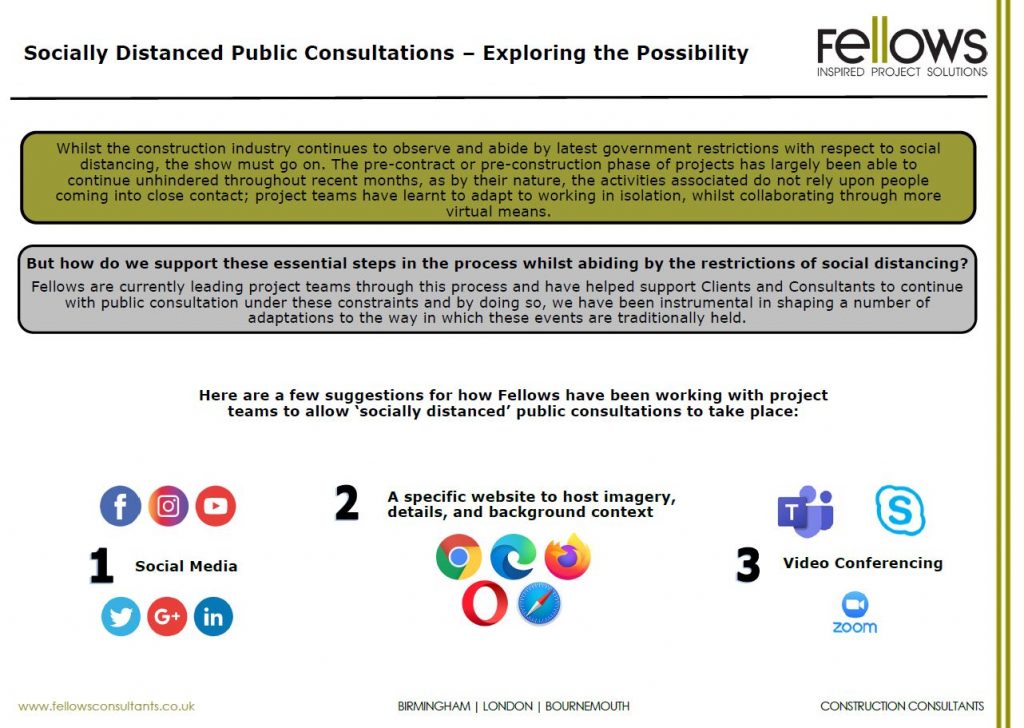
Whilst the construction industry continues to observe and abide by latest government restrictions with respect to social distancing, the show must go on. The pre-contract or pre-construction phase of projects has largely been able to continue unhindered throughout recent months, as by their nature, the activities associated do not rely upon people coming into close contact; project teams have learnt to adapt to working in isolation, whilst collaborating through more virtual means.
However, it is inevitable at some stage in the project, it will be necessary to take the stabilisers off and subject the plans to the scrutiny of others. In particular, the public, who are quite often key stakeholders with interest of varying degrees in the scheme. The public consultation is often a well-attended event consisting of large number of people gathering to listen to the proposals and provide their view ‘live’ to the panel of professionals who represent the proposed development. The Q&A forms a key feature in the consultation, which is often aided by scaled plans, mock-ups, models, CGI’s, fly-throughs, and capitalising on the latest technological developments, augmented and virtual reality.

But how do we support these essential steps in the process whilst abiding by the restrictions of social distancing? Fellows are currently leading project teams through this process and have helped support Clients and Consultants to continue with public consultation under these constraints and by doing so, we have been instrumental in shaping a number of adaptations to the way in which these events are traditionally held.
Firstly, it is important to mention that the strategy for the public consultation must firstly be approved by the local planning authority (LPA) before any steps are taken to initiate it. The LPA will be keen to understand how the ‘audience’ will be selected, contacted, integrated and given the opportunity to provide feedback.
Here are a few suggestions for how Fellows have been working with project teams to allow ‘socially distanced’ public consultations to take place:
- Social Media is a powerful platform to broadcast messages to a broad audience. This can be used to harness interest in those wishing to participate. It can also be used to advertise the details for when the consultation will take place.
- A specific website can be generated to host imagery, details, and background context on the scheme, as well as hosting 3D visuals and fly-through models. This way, the participant can explore the material at their leisure. It would be advisable to have a start and expiry date for the website to correspond with the window for consultation. The website could have a function for feedback to be left, either by free-text or questionnaire, tailored to give more targeted comments from participants.
- Video conferencing can be used to great effect. This platform can be used for the project representatives to ‘present’ the scheme to the audience, whilst integrating supporting text/ imagery as one would normally, during a traditional consultation presentation. One project team or LPA member would be in place to preside over the session and who would gather selected questions from the audience, to pose to the project team. The video conferencing can be open to anyone who registers interest, or alternatively closed-off to selected participants from a chosen group.
The above ideas can be used effectively in conjunction with each other, in order to afford the best opportunity for engaging with the participants and providing a comprehensive description of the proposed scheme, whilst maximising the opportunity for two-way feedback, which is essential in demonstrating integration with stakeholders.
Feel free to contact Fellows for more information and advice on any projects that you have in-mind or underway, we would be happy to take your call.